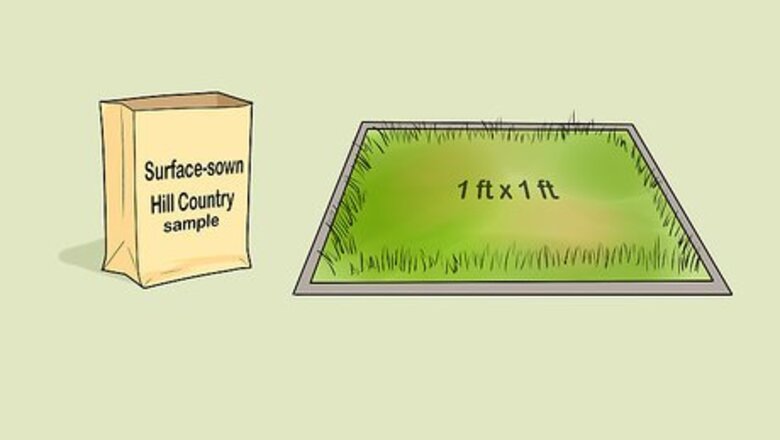
views
Pasture forage yield and productivity is the biggest variable that is the most prone to change. Weather conditions play a significant role, as well as management practices. Typically average annual precipitation pre-determines how much forage is available on average for livestock from year to year. However, when making management decisions for your farm or ranch, often such averages may be somewhat unreliable.
Thus it is important to know how to develop your own stocking rate numbers for your farm or ranch. This article will assist you with understanding the basics of how to calculate stocking rates for your pastures based on forage availability, the size of your animals, and how much they will eat.
Calculating Stocking Rates Using The Standard AUM (Animal Unit Month)
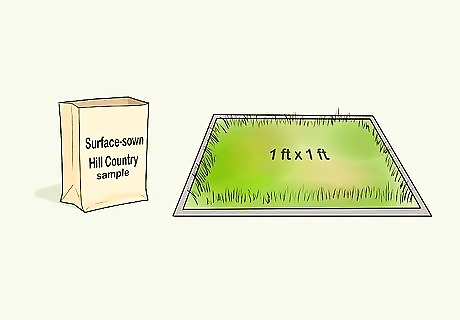
Determine forage yield or quantity in your pastures. Even though it's much easier if you obtain such information from a local county, state, or provincial agricultural extension office, it's more precise to begin to develop the values for your operation. Doing so takes a bit of time, diligence, a grazing stick (or just a yard stick), and a cheap microwave for the barn. In order to get forage yield of your pastures you may need to do a bit of clipping in different sites around the pasture. Find a random spot in the pasture, and stake out a 1 ft x 1 ft area. Clip the forage inside that square to about a 2-inch (4.5 cm) height, and put it in a brown paper bag. Label the bag to know which pasture it came from. Ideally, you should take about 10 or more of such clippings in the same pasture to get an albeit small representative sample size, however two to five clippings in random spots (never choose just the best areas) will work. Take those forage samples, weigh the container you are going to put them in, then weigh the samples plus the container. To eliminate the weight of the container including the sample subtract the weight of the container to get the weight of the sample. This is useful if your weigh scale does not have a "tare" or zeroing function on it (most scales should). If your scale can be zeroed, then set the container on it, tare it to zero, and then put the sample in. Dry the sample in a microwave oven, each session 1.5 to 2 minutes long, and keep a cup of water with the sample in the microwave to prevent it from burning. Weigh the sample after each session, repeating until the weight of the sample is no longer decreasing. Record the weight as a dry weight, and repeat with the other samples collected. Once you have dried and weighed all the samples, take an average of all the final dry weights. To get forage yield in terms of pounds per acre, simply multiply the average result by 43,560 square feet to convert pounds per square foot to pounds per acre. 1 acre = 43,560 square feet. Another method, which is much less time-consuming and tedious, but takes much more practice and head-arithmetic, is using a grazing stick. A grazing stick is basically just a yard stick with formulas on the side to calculate the amount of forage is in your pasture. Put the end of the stick down to the ground, and measure the height of the sward 15 to 20 times (never stretching the leaves of the plants up the stick) to get an average forage height in inches. Next, estimate forage density based on green plant cover. This is done visually, looking directly down where you are standing. Density is the amount of ground surfaced by the forage stand. It is usually based on three criteria: less than 75 percent (> 75%), between 75 to 90 percent (75 - 90%), and more than 90% (<90%). Based on the forage type of your stand and the density estimate, multiply average plant height by the dry matter yield, in pounds per acre-inch, of the forage type. This will give you an estimate of the amount of forage you have available per acre. Please see the references below for tables of forage types and more info on calculations below. For example, with multiple measurements you came up with 10 inches (25.4 cm) of forage height. Looking at the density, you estimate that there is around 80% plant density. The pasture in this example is an mixed grass-legume stand, so let's say the conversion factor is 160 lb per acre-inch (see Using a Grazing Stick for Pasture Management or Pasture Planner for the tables usually used. Note the first link is from the Southeastern part of the United States, the second is based on pasture productivity for Western Canada, and are all average values for the respective regions). Thus, 10 in. x 160 lb/acre-in. = 1,600 lb/acre.
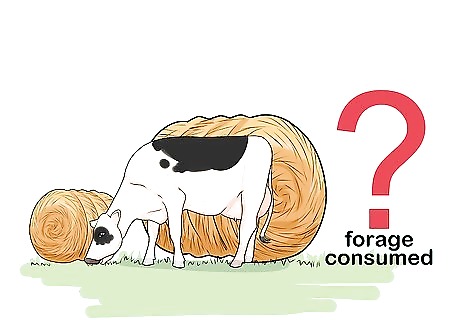
Estimate the Utilization Rate for your pasture. The utilization rate is defined as the amount of forage expected to be consumed by the animals relative to the amount that should be left behind as trampled residue, It is on a percent basis. For most pastures, most stocking rates are typically calculated using a 50 percent utilization rate, or "take half, leave half." However, if the plant density is lower than 75 percent and forage height is 6 inches (15.2 cm) or less (a short, thin stand with a bit of bare ground showing between plants), the utilization rate should be low, such as 25 or 30 percent. For this example, let's assume that this pasture is going to see a 50-percent utilization rate. Some rules of thumb to remember for utilization rate are: the longer the animals remain on pasture, the lower the utilization rate must be in order to reduce incidence of overgrazing. Also, the poorer the pasture, the less forage is available to eat, and the less the animals are able to graze, therefore the lower the utilization rate.
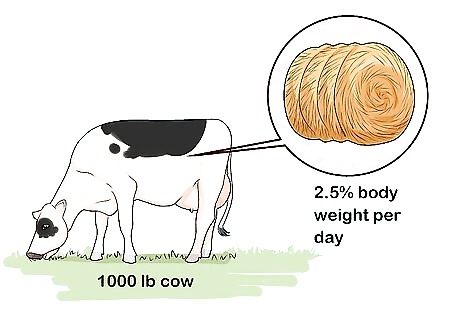
Understand the standard animal unit. One Animal Unit (AU) is equal to one 1000 lb cow or cow-calf pair consuming 2.5 percent of body weight in dry-matter forage per day. On average, that cow or cow-calf pair is expected to consume around 800 lb of forage per month. This is the AUM or Animal Unit Month. The AUM is the standard, fixed variable used in all stocking rate calculations, no matter the forage type or resource, and no matter what animals you are grazing.
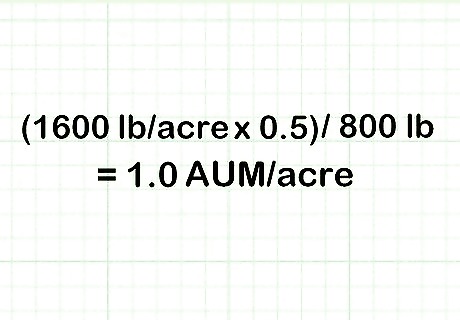
Perform the calculations to get your operation's stocking rate. The formula for stocking rate is (Forage Yield (lb/acre) x (Utilization Rate (%)/100)) / AUM. Via the examples created in this article, the stocking rate example is (1,600 lb/acre x (50%)/100) / 800 lb = 1.0 AUM/acre.

Understand which variables are fixed and which are not. Forage yield is the major variable that is most prone to change. Utilization rate is directly influenced by forage yield. This is why it's very important to measure the amount of forage available in your pasture so that you have a more accurate analysis of what works on your operation. Keep records of your pasture forage yields on a spreadsheet so that you are able to see trends and begin to develop your own benchmark. This may also help you see where you can improve your grazing management practices. Grazing sticks can be purchased at a local county extension office or applied research organizations. Please note that grazing sticks are actually much more ideal for use on tame pastures. They tend to be less reliable when measuring native grasslands due to the much higher variability that can be found in such areas, unlike with a tame pasture that is almost always fairly uniform across the land base.
Calculate Stocking Rate for Actual Number of Animals
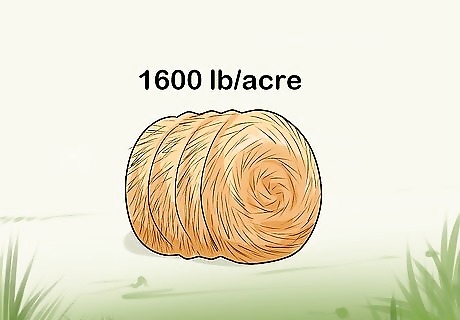
Determine forage quantity or yield of your pastures. The methods discussed above are exactly the same for this method. Assume that you came up with an estimated 1600 lb/acre of forage.
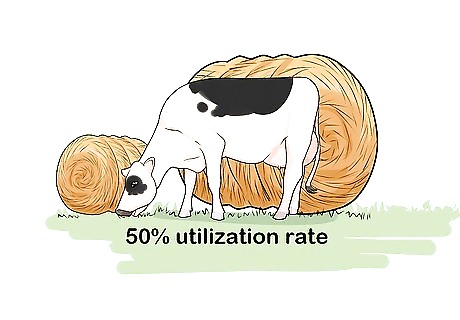
Estimate the desired utilization rate. As mentioned, typically utilization rates are on a take-half, leave-half scenario. For this example, let's stick with the 50% standard already mentioned.
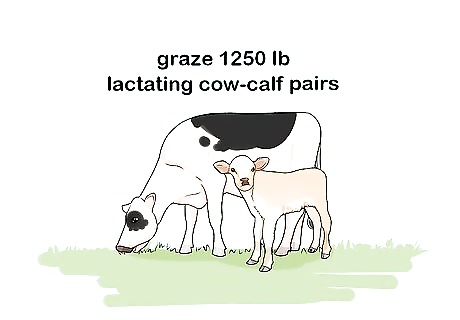
Get the weights of your animals. At this time it's safe to remind you that this method of stocking rate calculation is pertaining to your own individual animals. You will need the average weights of whatever animals you're grazing, whether they are sheep, goats, horses, cattle, llamas, bison, elk, etc. To continue this example, let's assume you're wanting to graze 1250 lb lactating cow-calf pairs. Note that calf weight is "included" in the cows' weights when calculating for cow-calf pairs. As a general rule, calves do not eat a significant amount of forage until they reach weaning. This step is of great importance because today's modern cow size is much larger than the size of the cow that was common in the 19th and 20th centuries. Cow size must be taken into account to reduce the chance of overgrazing. Larger cows eat more than smaller cows, therefore less large cows can be grazed than small cows.
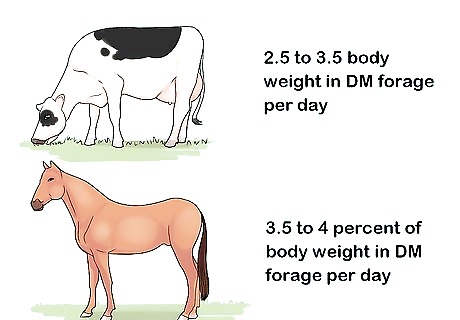
Estimate the amount your animals eat per day on a percent-body-weight basis. Cattle typically consume anywhere from 2.0 to 3.5 percent dry matter (DM) of their body weight per day. Lactating dairy cows and young growing cattle typically consume 2.5 to 3.5 percent of their body weight per day. Horses eat close to 3.5 to 4 percent of their body weight, and sheep and goats (lactating) generally consume around the same as most cattle (typically between 2.5 to 3 percent of their body weight). Let's assume these cows are consuming 2.5 percent of their body weight in dry-matter (DM) forage per day. This percentage is also known as the amount of forage or feed an animal will eat per unit of body weight per day. From the example above, a 1250-pound cow can be expected to eat 0.025 pounds of forage per pound of body weight per day.
Calculate the amount your animals will eat in a day. Using the average body weight of your livestock and multiplying it by the amount they consume per pound of body weight (see previous step) will provide you with the amount of forage, on a dry-matter basis, your animals will consume per day. Per our example, the calculations are as follows: 1250-pound cow-calf pair x 0.025 = 31.25 pounds of forage per day.
Calculate the amount your animals will consume in a month. Because the standard stocking rate calculations are based on how much a standard animal unit (one 1000-pound cow with or without a calf) will consume per month, it is also important at this point to know how much each of your animals, on average, will consume per month. To do this we take the value obtained from the previous step, and multiply it by the average number of days per month, which is typically 30.5. From our example, a 1250 pound cow-calf pair will consume: 31.25 pounds per day x 30.5 days per month = 953.13 pounds of forage per month.
Calculate your stocking rate for your pastures. To bring it all together, we use the same formula as above, except that the forage-consuming equivalency of the standard AUM (animal unit month) is replaced by the amount of forage that the average animal in your herd consumes per month (see previous step). The calculations are as follows: (1600 pounds x (50%/100)) / 953 pounds = 0.84 actual number of animals per acre per month.
You may use this calculation to estimate how many animals are needed per pasture, or how much pasture is needed for a certain number of animals. Stocking rates are built so that it helps you give you an idea and a guideline to how much space or how many animals should be stocked for the entire grazing season. They have been created to help you reduce the chance of overgrazing and over-stocking pastures.














Comments
0 comment